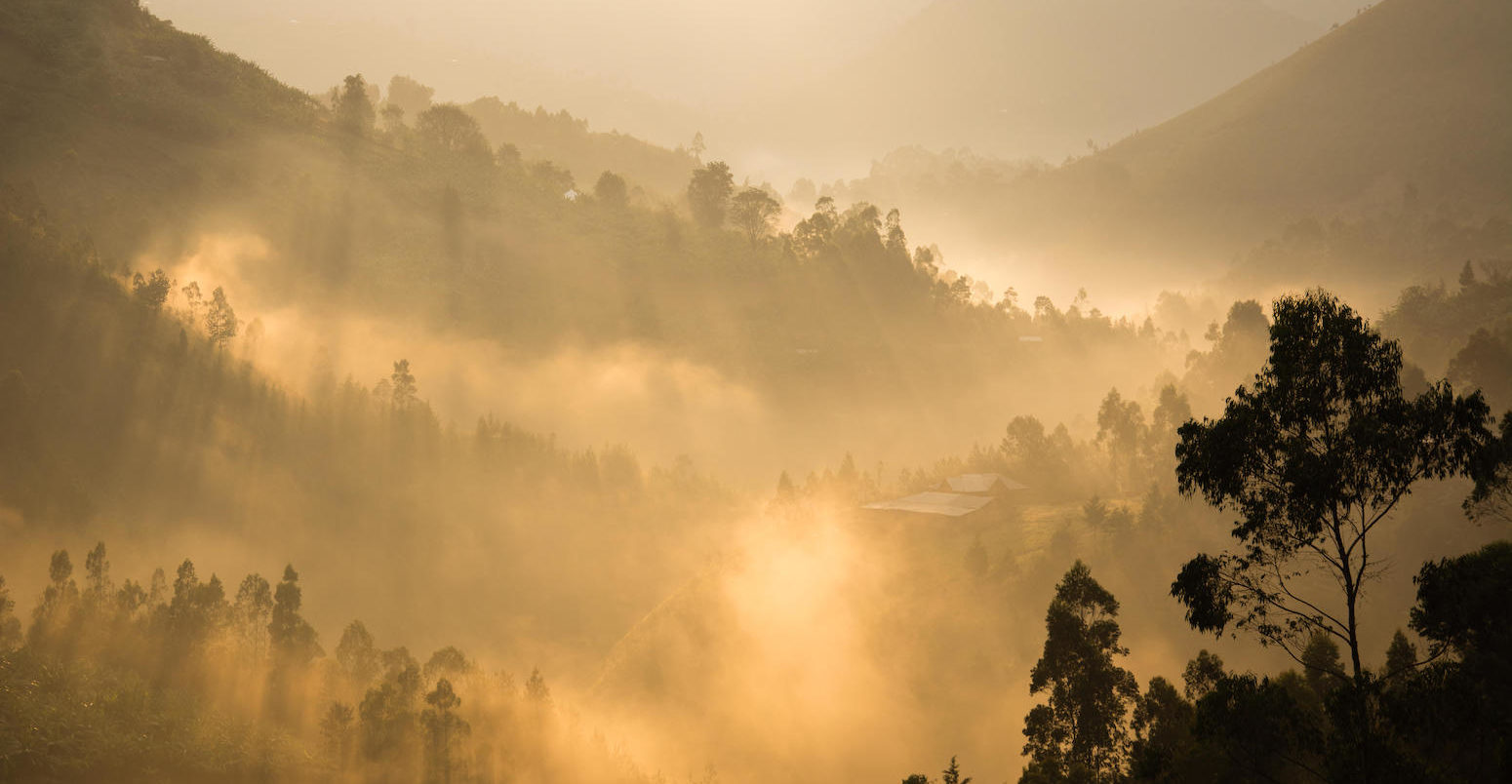
Endangered African montane forests could be a key ‘carbon store’, scientists say
Aruna Chandrasekhar
09.14.21Aruna Chandrasekhar
14.09.2021 | 4:44pmTropical forests on the slopes of Africa’s mountains are more concentrated stores of carbon than the Amazon, a new study in Nature suggests.
The research on these “montane” forests was carried out by more than a hundred scientists and shows that their carbon stocks are about two-thirds higher than estimates used by the Intergovernmental Panel on Climate Change (IPCC).
The study also shows that these African “cloud” forests are being felled at a higher rate than previously thought, with more than 0.8m hectares lost since the turn of the century. If current levels of deforestation continue, the authors estimate that another half a million hectares – an area roughly twice the size of Luxembourg – could be lost by 2030.
“We were quite surprised. We expected [their carbon stocks] to be higher than the literature, but not as high as we found,” study lead author Dr Aida Cuni-Sanchez tells Carbon Brief. She adds: “There’s not a lot of these forests left and they never get a lot of attention.”
Sonam P Wangdi, chair of the Least Developed Countries (LDC), tells Carbon Brief that countries should be rewarded for protecting these carbon stores and says the Article 6 mechanism under the Paris Agreement should allow trading to support this.
Old-growth evergreen forests
Tropical montane rainforests are humid, biodiverse ecosystems found in the mountainous regions of Africa, Asia, the Americas and equatorial Oceania. They typically occur at elevations between 1000 metres and 3,500 metres above sea level, defined by their dependence on cloud cover that keeps tree crowns immersed in mist.
Montane forests make up most if not all of the evergreen old-growth forests in 10 African nations, the paper says.
The new research, led by the University of York’s Dr Aida Cuni-Sanchez, spans a dataset of intact old-growth forests in 44 montane rainforest areas – shown in purple below – across 12 African countries: Burundi, Cameroon, Democratic Republic of the Congo (DRC), Ethiopia, Guinea, Kenya, Mozambique, Nigeria, Rwanda, Tanzania, Uganda and Zimbabwe.
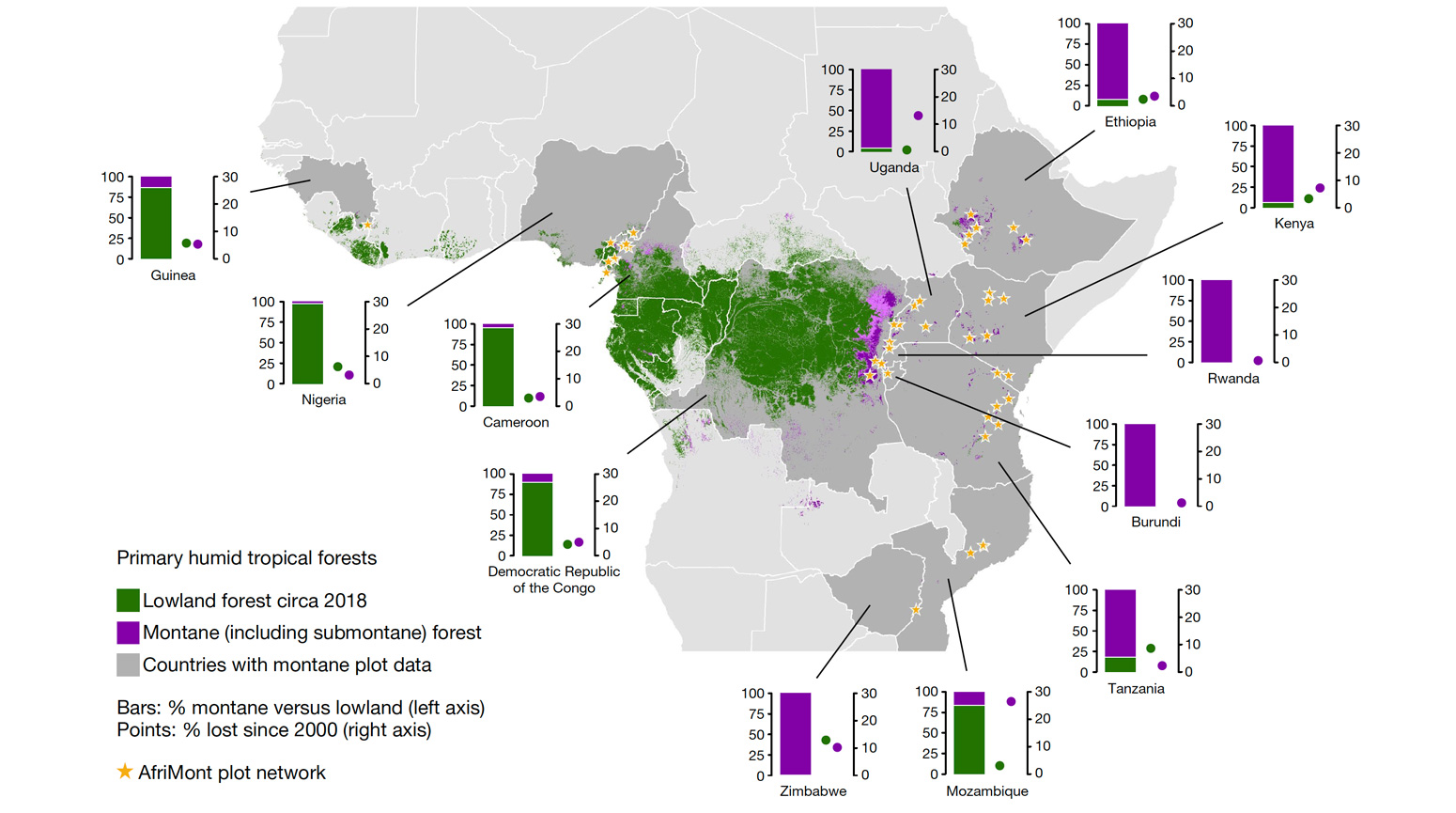
In addition to everything else they are and provide, forests are reserves of carbon. They are carbon sinks when they grow in area or accumulate biomass and can become carbon sources when they burn or are disturbed by human actions or natural phenomena.
Old-growth or “primary” rainforests are relatively untouched by human pressures. They have a full canopy that allows very little light to get in, resulting in a forest floor that is largely clear of dense vegetation. Secondary forests, on the other hand, have been altered by human or natural disturbances. Canopies are often not as tall, trees are shorter, floor vegetation is more dense with fewer species.
Tropical rainforests cover very little of the planet, but store a lot of carbon: nearly 40–50% of terrestrial vegetative carbon is locked away in their biomass.
Although they are often thought of as a uniform, single entity, there are large differences between tropical rainforests across countries, regions and landscapes, explains study co-author Dr Martin Sullivan from Manchester Metropolitan University.
Lowland forests in Africa tend to have a low density of trees, but a high density of tall trees that store lots of carbon, he tells Carbon Brief:
“We found that this distinctive character is also found in Africa’s montane forests. There are just as many big trees in montane forests as in lowland forests.”
To establish if montane forests are a carbon source or a sink will need repeated measurements, co-author Prof Simon Lewis from the University of Leeds and University College London tells Carbon Brief.
This new paper comes on the back of his team’s past work that found high carbon stock in African lowland rainforests. Cuni-Sanchez proposed they replicate the work in montane forests, where there were little to no recent studies.
The results were startling even for the scientists involved in the research, they say, given the challenging conditions that distinguish montane forests, which might have been expected to limit tree growth, including high altitudes, strong winds, steep slopes, lower temperatures, long periods of cloud immersion and soil waterlogging.
They measured more than 72,000 tree stems, recording stem diameter, species and tree height.
At the first site that Cuni-Sanchez visited in Kenya for the study in 2014, “the trees were quite short, with twisted branches”. But, in the small valleys between two hills, she found very large and tall trees: “A huge variation in forest structure and not just in terms of species.”
On average, the team found the montane forests contained 149.4 tonnes of carbon per hectare, two-thirds higher than the IPCC’s latest estimates.
“When we put it all together, it turns out…we were quite surprised. We expected it to be higher than the literature, but not as high as we found,” says Cuni-Sanchez.
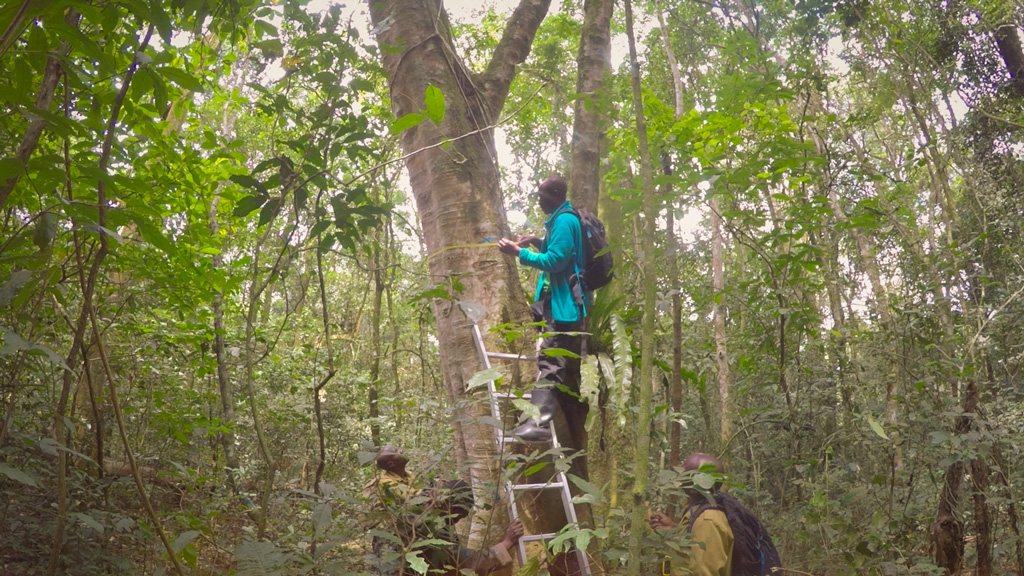
Defaults and data scarcity
Measuring carbon stocks helps to quantify losses from deforestation and forest degradation.
Countries are required to report their anthropogenic emissions and removals of greenhouse gases to UN Climate Change (UNFCCC), as part of the Paris Agreement and other mechanisms.
Inventories are tools for countries to monitor impacts and report progress towards their national climate pledges, which could include deforestation targets. Datasets collected can also be used to develop policy and secure finance for national and joint climate change mitigation and adaptation strategies.
The IPCC’s Task Force on National Greenhouse Gas Inventories frames common guidelines and a methodology for governments to account for emissions in their national territories. It prescribes indicators and sets default values for each sector, based on existing scientific and empirical literature. The guidance on forestry, for instance, lists carbon biomass defaults for different kinds of forests across the world.
These methodologies are updated from time to time to “maintain their scientific validity” and keep up with the best available science, but this is not periodic: revisions were made in 1996, 2006, 2013 and 2019.
The 2019 refinement does not specify a default value for old-growth montane forests in Africa. Instead, it provides a mean value for young and old secondary forest and primary forest carbon stocks, drawn from five sites – against the 44 included in the new study.
“One of the strengths of the 2019 update of the IPCC biomass defaults was that it was able to distinguish between old-growth and secondary forests in most areas, but this was not possible in African tropical montane forests,” Sullivan tells Carbon Brief.
Data on these mountainous regions, like many biomes in Africa, is scant. This is due to several reasons.
First, developing countries can lack the legal architecture, technical know-how, human, institutional or financial capital to carry out studies like these, or report on the many indices that inventories require.
Second, not all these forests are easy to access. Prolonged conflict and political unrest over decades meant that some of the study sites were off bounds for security reasons. In countries such as the DRC, armed rebels frequently attack forest guards and outsiders. Indigenous communities and refugees are often caught in the crossfit of militarised conservation approaches. Even remote-sensing surveys are difficult to execute in the mountains, researchers said.
The third issue is the IPCC’s own processes for compiling its volumes, which Cuni-Sanchez says can sometimes be static, inflexible and delayed.
“Expert reviewers can only use studies that have been published in English, in good peer-reviewed journals. Many reports in Africa are published in French and other languages,” Cuni-Sanchez tells Carbon Brief.
Media reports cannot be included in assessments. Articles only within strict time-ranges can be cited, forcing reviewers to miss out on the latest available science still in review or hard-to-find papers that were previously overlooked.
“In the end, you are often constrained by the approach used for these large reports. Not just the publications that are out there, which, for Africa, are always less than for other parts of the world, but also by the framing. As a scientist, I wish it were slightly more flexible and inclusive,” Cuni-Sanchez says.
Cloud forests and climate change
Recent studies have shown that tropical forests are losing their ability to remove CO2 from the atmosphere, having reached their “peak carbon uptake” in the 1990s. While they could still absorb high levels of CO2, this is contingent on them being left intact and warming being limited to 2C.
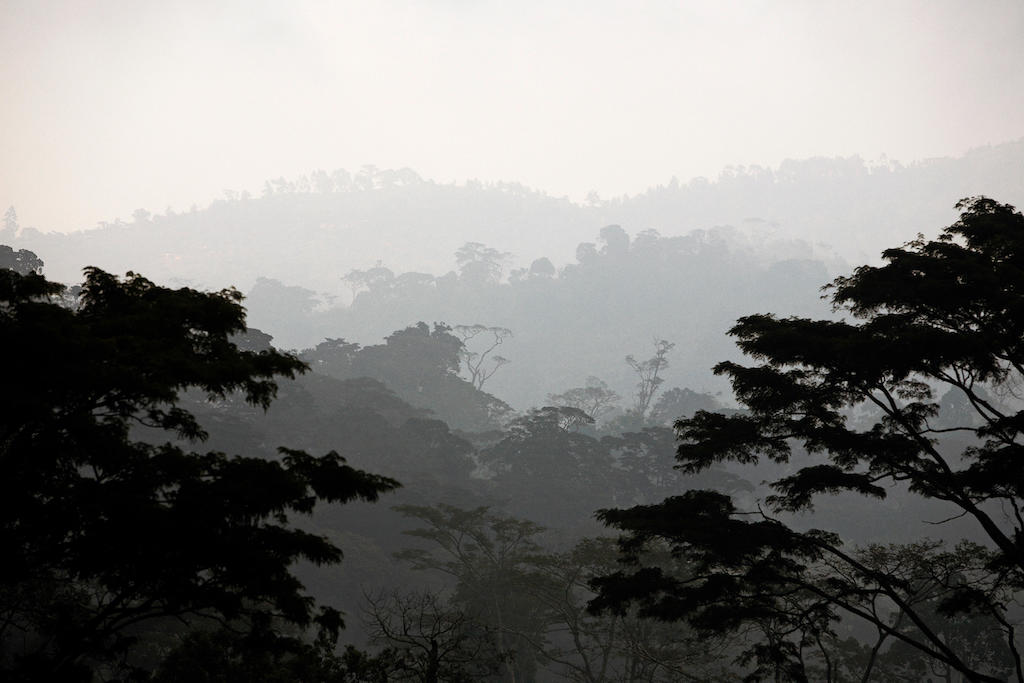
While the new research shows that montane forests are large stores of carbon, it is unclear if they are sources or sinks and how this could change as the climate continues to warm.
Carbon uptake by cooler montane forests could be safer from warming temperatures compared to lowland tropical forests, Sullivan tells Carbon Brief. However, climate change could be a serious threat to the cloud cover that feeds water to these forests in otherwise arid regions, he says:
“Many montane forests are covered by clouds for part of the year and this can provide important water inputs that could sustain forests in areas that might otherwise be too dry. But, as temperatures warm, cloud bases are expected to be pushed upwards so that they may end up being above the tops of mountains.”
However, Lewis thinks montane forests could be a bigger sink (per unit area) than even African lowland forests. In the lowlands, increasing CO2 concentrations could spur tree growth. But warmer and drier air temperatures can reduce their ability to store carbon. In the mountains, rising CO2 levels should roughly have the same effect, but starting from a cooler temperature baseline should encourage, not affect tree growth. He adds:
“In Africa, the rate at which trees die and then recruit into a forest stand of trees is very low. What this means is trees are, on average, living longer in Africa and so have more time to accumulate carbon.”
The slower dynamics of trees in African forests, combined with recent research that shows lowland forests are still operating as a large carbon sink, could imply [African forests] are resilient to environmental changes that have occurred over recent decades, says Lewis.
But he fears that, as environmental change intensifies, African forests’ ability might not be able to respond fast enough. “Surprises may be in store in the future,” he adds.
Conservation and restoration
Carbon stocks aside, Africa’s tropical montane forests are among the most biodiverse regions on Earth. The Albertine Rift region’s montane forests, for instance, are home to more than a thousand endemic plant and animal species, including endangered mountain gorillas.
Cuni-Sanchez recalls running into one during her research. “I was paralysed. Let’s just say running in the rainforest is difficult, particularly when wearing rainboots and carrying a heavy bagpack. People are surprised when I say that I came here for the trees, not the gorillas,” she says.
The forests serve as “water towers” for rivers that millions of people depend on. But they are rapidly under threat from mining, logging, farming and political conflicts, says the paper.
Many East African countries whose montane areas were part of the study have committed to forest restoration as part of the “Bonn Challenge”. This is a global commitment that aims to have restored 150m hectares of degraded and deforested lands by 2020 and 350m hectares by 2030.
The studied countries’ 2020 Bonn Challenge targets are shown in the table below, which also details montane and lowland rainforest area, forest loss and the average above-ground carbon stocks of these forests.
Countries with the highest absolute montane forest cover – such as DRC, Ethiopia, Cameroon and Kenya – have lost large tracts of these old-growth forests over the past two decades, the study shows, in spite of their high restoration commitments.
Countries whose montane forests have the highest carbon stocks per hectare – Guinea, Mozambique and Zimbabwe – have the least land under these forests. Moreover, the study finds that over the past two decades, Mozambique, Uganda and Zimbabwe lost 27%, 13% and 10%, respectively, of the montane forests that were still standing in 2001.
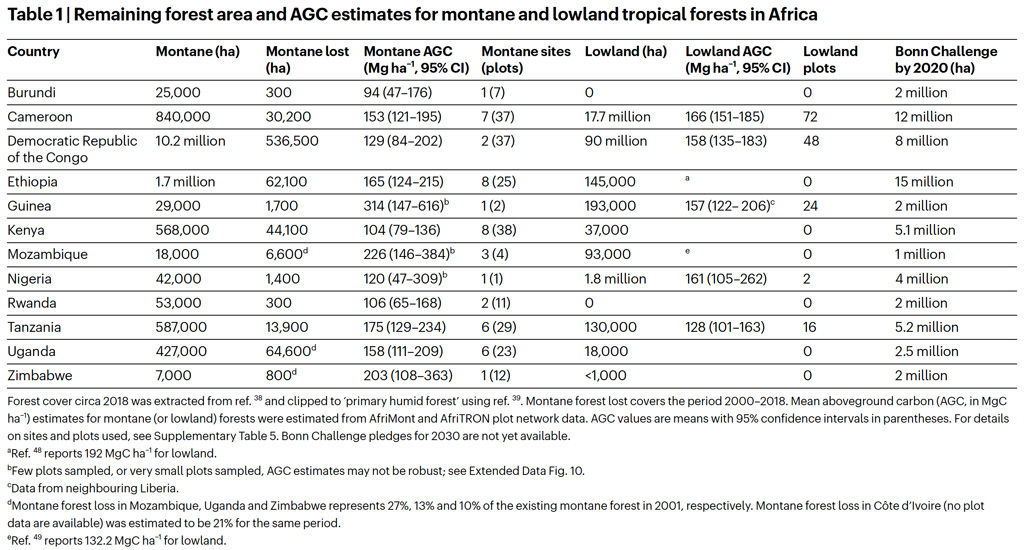
Cuni-Sanchez thinks that the study could help motivate countries to meet their forest protection targets under the Bonn challenge. She tells Carbon Brief:
“If you restore your degraded montane forests, you could actually get a lot of carbon stored and then maybe – through carbon financing mechanisms – you could actually get some money for conservation in countries where resources for conservation are rather limited.”
According to the IPCC’s 2019 special report on climate change and land, the largest potential for reducing emissions from agriculture, forestry and other land-use are “through reduced deforestation and forest degradation” (0.4-5.8bn tonnes of carbon dioxide equivalent per year, GtCO2/year). It anticipated that a quarter of emissions reductions pledged by countries in their first nationally determined contributions (NDCs) under the Paris Agreement would come from land-based mitigation options.
Some 56 countries, which account for more than 70% of the world’s natural forest cover and for nearly two-thirds of natural forest loss, chose to include strategies to reduce emissions from deforestation and forest degradation (REDD) in their first NDCs, earlier research found.
Of these, only a few referred to specific financing instruments or set quantifiable mitigation targets for preventing deforestation. Forest governance, social safeguards and indigenous Free Prior Informed Consent (FPIC) were absent in most INDCs.
Ethiopia’s updated NDC published in July 2021 identifies land-use change and forestry to be the sector with the highest potential to reduce emissions. If it receives international support, it aims to restore 5m hectares of forest land by 2030, 10% of which is montane forest.
Kenya and Rwanda’s updated pledges also refer to forest-based mitigation.
Approaches to preventing deforestation through carbon finance are an undecided element in the Paris Agreement’s rulebook: forest schemes are not currently in the Article 6 “sustainable development mechanism”, the global carbon market scheme set to replace the Kyoto clean development mechanism (CDM).
Countries outside of East Africa, such as Indonesia or Brazil, could stand to gain as sellers of carbon credits if “nature based solutions“, such as forest rehabilitation, could be traded. This is because forest restoration offers the biggest potential to sequester carbon globally.
However, at COP25, Brazil was reported to be “strongly advocating against the use” of forests within the Article 6, even if it could benefit from it.
Eight out of the 12 countries whose montane rainforests have been assessed in the study are among the world’s least-developed.
Carbon Brief spoke to Sonam P Wangdi, chair of the Least Developed Countries (LDC) negotiating group, who said:
“LDCs should be rewarded for keeping our forests intact. Environmentalism should have a value. Currently, it doesn’t have any value. Under Article 6, sinks don’t have any value, it covers mitigation only. There’s a difference between a new plantation and ancient forests and any trading mechanism should be flexible enough to allow us to value assets. You can only trade a reduction. But we have surplus. We should be entitled to trade.”
Wangdi cites the example of his own country, Bhutan. “We are carbon negative, by leaps and bounds: our sequestration is about 9.8m tonnes, but our emissions are 3.8m tonnes. But, currently, we get nothing for it. It has been known for quite some time that the ancient forests store more carbon.”
He acknowledges that previous carbon-financing regimes have had their flaws:
“There were many issues with the Clean Development Mechanism. We need to learn from them and do better, especially on environmental integrity: actions should lead to real benefits, not just to artificially meet targets.”
Nevertheless, he argues that there should be a standard of assessing quality and for monitoring and verifying avoided deforestation emissions. This would enable such savings and conservation of old-growth forests to be rewarded.
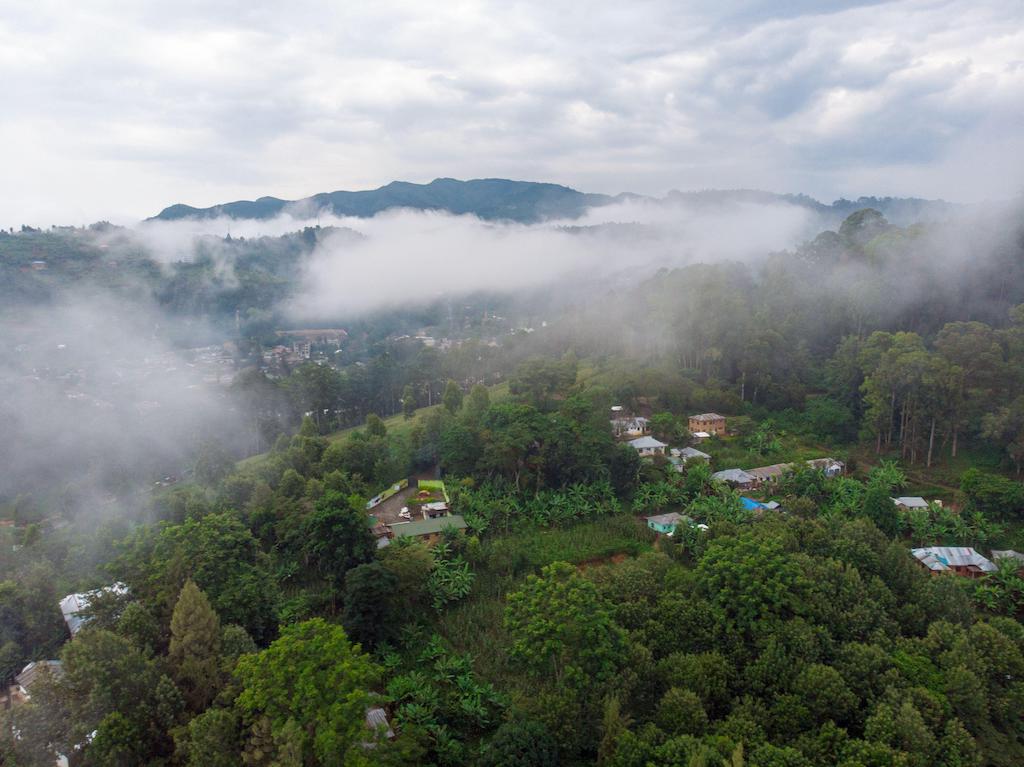
Old growth versus new growth
In March this year, French oil giant Total announced a partnership with the DRC to plant a 400,000-hectare forest. It says the project “will sequester more than 10m tonnes of CO2 over 20 years” and is part of its commitment “to the development of natural carbon sinks in Africa”.
In the 30-year lifespan of a carbon project, project owners planting trees can expect to sequester roughly 50 tonnes a hectare in the best conditions, Cuni-Sanchez tells Carbon Brief. But, by avoiding deforestation, they could avert nearly 150 tonnes of CO2 emissions. She says:
“The trees continue to grow, so you will still save more over time. To me, in countries that already have forests and the issue of deforestation is big, what is the point in planting a few trees?”
Lewis agrees, telling Carbon Brief that the focus should be on ending deforestation:
“If the world is going to close the emissions gap and actually halve CO2 emissions by 2030 then almost entirely ending deforestation by 2030 will need to be part of a broad package of measures. New funding sources to help keep forest standing will need to be integral to any successful set of measures, with payments for carbon, protecting biodiversity and other services that ecosystems provide can be part of that.”
Cuni-Sanchez, A. et al. (2021), High aboveground carbon stock of African tropical montane forests, Nature, doi:10.1038/s41586-021-03728-4.
-
Endangered African montane forests could be a key ‘carbon store’, scientists say

